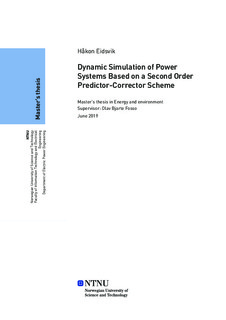| dc.description.abstract | I denne masteroppgaven har den andreordens prediksjons-korreksjonsmetoden Gears metode blitt implementert i programmeringsspråket Python. Dette er en utvidelse av implementasjonen i spesialiseringsprosjektet. Gears metode er en numerisk integrasjonsmetode som brukes for å løse systemer av differensial-algebraiske ligninger (DAL-systemer). Metoden benytter selvregulerende steglengder, hvor steglengden bestemmes basert på estimert feil i hvert steg. Dette gjør metoden i stand til å simulere tilstandsrommodeller av kraftsystemer som består av et bredt spekter av tidskonstanter, som impliserer at systememodellen beskriver både raske og trege fenomener. Hvert steg og hver kalkulasjon i Gears metode er utfyllende beskreved i appendikset.
Et litteraturstudie av numeriske integrasjonsmetoder, deres stabilitet, bruk og motivasjon har blitt utført. Dette resulterte i en teoriseksjon som fungerer som en base for å forstå numeriske integrasjonsmetoders applikasjon i kraftsystemer, behovet for stabile metoder og motivasjonen for å bruke variabel steglengde.
En strategi for justering av steglengden er brukt på to systemmodeller. Det første systemer består av en synkrongenerator koblet til et stivt nett via to parallelle transmisjonslinjer, hvor den ene utsettes for en kortslutning. Det andre systemet består av en spenningsregulator, forsterker, generator og en måleanordning. Steglengdestrategien viser seg å forbedre algoritmens ytelse, og den er i stand til å detektere stabil tilstand raskt og øke steglengden i henhold til det. Dette harmoniserer med funn gjort i litteratur og spesialiseringsprosjektet.
Problemer oppstår imidlertid når de to systemet utsettes for forstyrrelser. I tidspunktet forstyrrelsen introduseres synker steglengden. Den bruker litt tid på å øke igjen, og flere justeringer av steglengden er nødvendig. Fordi dette er beregningsmessig dyrt brukes en strategi for å reinitialisere tilstandsvariablene og deres deriverte etter en forstyrrelse. Tre ytelsesparametre relatert til justering av steglengde identifiseres for å ha et grunnlag for sammenligning mellom å bruke strategien for reinitialisering og å la algoritmen håndtere det uten ekstra funksjonalitet.
Regulator/forsterkersystemet beskrevet over utsettes for metningseffekter, og generator/stivt nett-systemet utsettes for den nevnte kortslutningsfeilen. I kortslutningstilfellet forbedres ytelsen med omtrent 5 % når systemet reinitialiseres med strategien mhp. ytelsesparameterne. I metningstilfellet registreres det ingen forbedring; resultatet er identisk med å la algoritmen håndtere forstyrrelsen på egenhånd.
Alle simuleringsresultatene presenteres grafisk, og tabeller som oppsummerer de mest interessante aspektene er inkludert. Noen uoverenstemmelser knyttet til steglengden i kortslutningssimuleringen observeres, diskuteres og vurderes videre i appendikset.
Til slutt presenteres anbefalt videre arbeid. Dette inkluderer å teste strategien for justering av steglengde og reinitialiseringsstrategiene på mer komplekse systemer, og å undersøke de inkonsekvente observasjonene fra kortslutningssimuleringen videre. | |
| dc.description.abstract | In this thesis, the second order predictor-corrector method Gear's method has been implemented in the Python programming language. This is an extension of the implementation in the specialization project. Gear's method is a numerical integration method used to solve systems of differential-algebraic equations (DAE systems). The method utilizes self adaptive step lengths, where the step length depends on estimated tracking error in each step. This enables the method to simulate state-space power system models with a wide range of time constants, implying that the system model describes both rapid and slow phenomena. Every step and every calculation involved in Gear's method is extensively described in the appendix.
A literature study of numerical integration methods, their stability, applications and motivation has been carried out. This resulted in a theory section that serves as a basis for understanding the application of numerical integration methods in power systems, the need for stable methods and the motivation for utilizing variable step length.
A strategy for adapting the step length is applied to two system models. The first system consists of a synchronous generator connected to an infinite bus via two parallel transmission lines, in which one of them is subject to a short-circuit. The second system consists of a voltage regulator, amplifier, generator and a measuring device. The step length strategy is found to improve performance of the algorithm, and it is able to identify steady state quickly and increase the step length accordingly. This harmonizes well with findings made in literature and the specialization project.
However, problems arise when the two systems are subject to disturbances. At the time the disturbance is introduced, the step length drops. It takes some time to increase again, and several step length adaptions are required. Because this is computationally expensive, a strategy for re-initializing the state variables and their derivatives after a disturbance is applied. Three performance metrics related to step length adaption are identified for the purpose of having a basis of comparison between applying the re-initialization strategy and letting the algorithm handle it without added functionality.
The regulator/amplifier system described above is subjected to saturation effects, and the generator/infinite bus system is subjected to the aforementioned short circuit fault. For the short circuit case, performance is improved by approximately 5 % when re-initializing the system with the strategy w.r.t. the performance metrics. For the saturation case, no performance increase is recorded; the result is identical to letting the algorithm handle the disturbance on its own.
All simulation results are presented graphically, and tables summarizing the most interesting aspects are included. Some inconsistencies in the short circuit simulation related to the step length are observed, discussed and further assessed in the appendix.
Lastly, further work is recommended. This includes testing the step length adaption strategy and the re-initialization strategies on systems of higher complexity, and further investigating the inconsistent observations made in the short circuit case. | |
